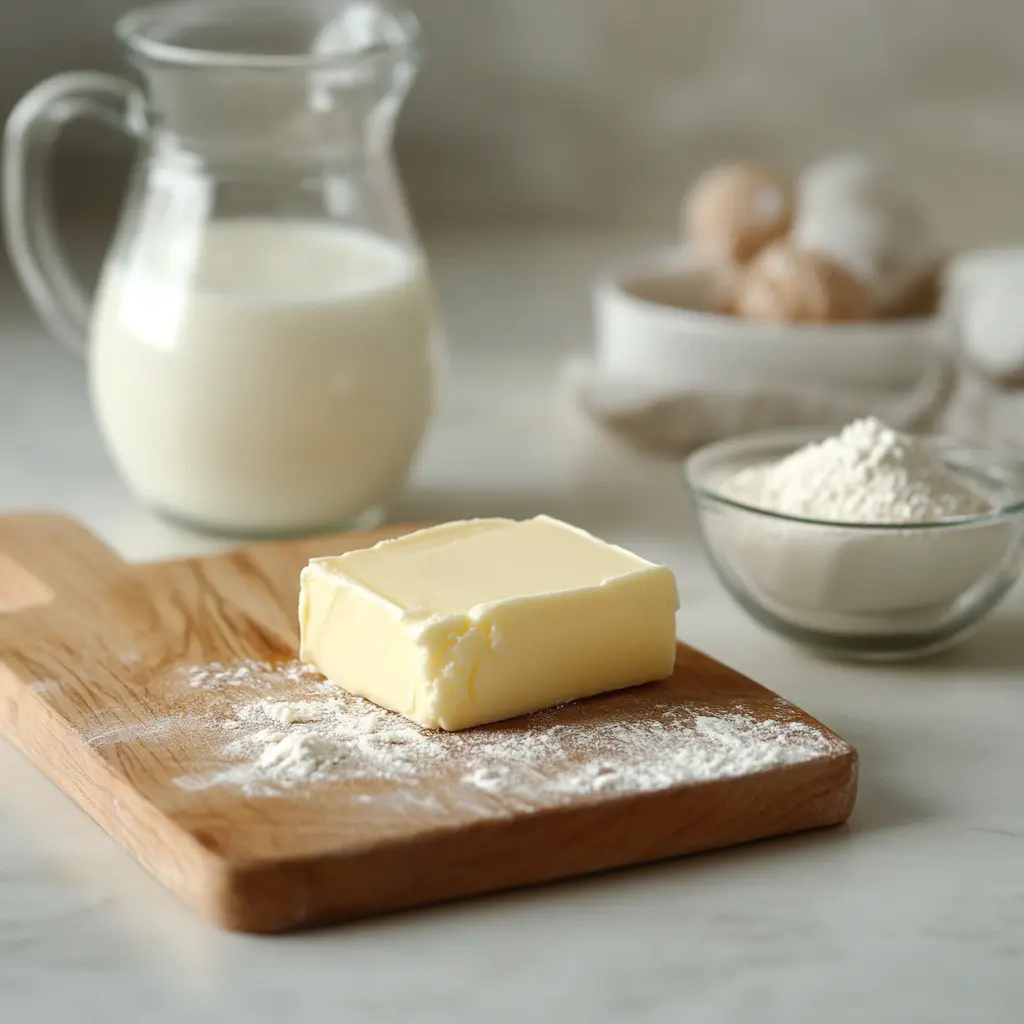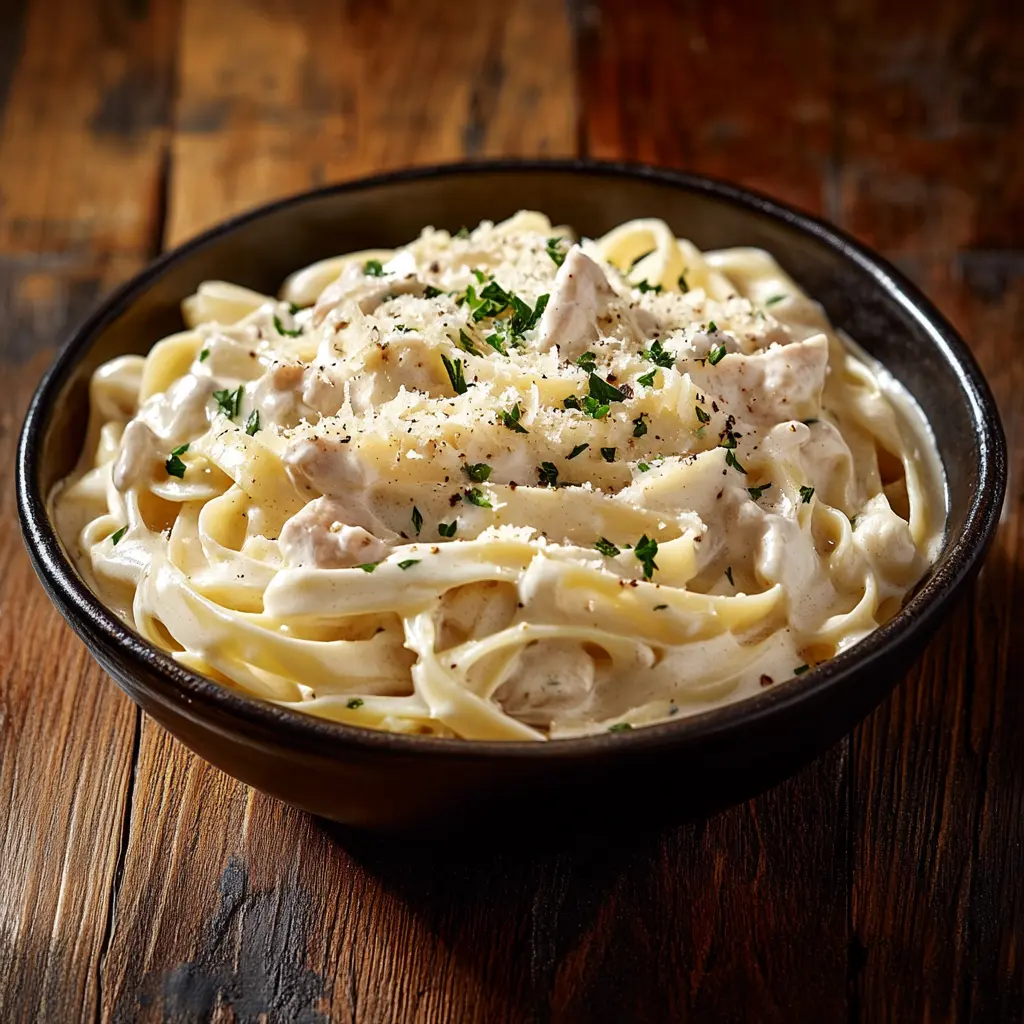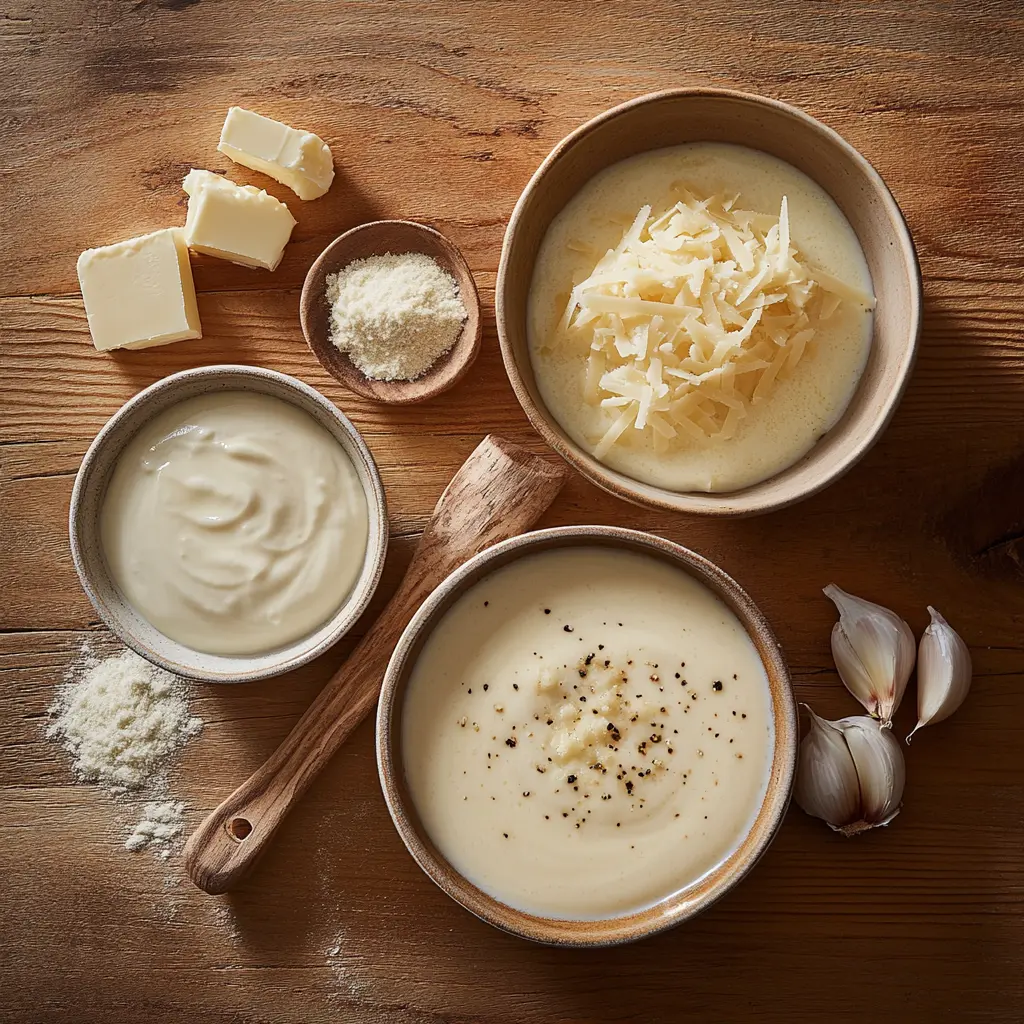Introduction
When it comes to creamy sauces for pasta, soups, or casseroles, white sauce and Alfredo sauce are often used interchangeably, yet they are surprisingly different. These two rich, velvety sauces come from distinct culinary traditions and have unique textures, flavors, and ingredients. White sauce, commonly known as béchamel sauce, hails from classic French cuisine, while Alfredo sauce has its roots in Italian cooking, particularly in Roman kitchens. Whether you’re a home cook or a food lover, understanding the differences between these sauces can take your culinary skills to the next level.
In this article, we’ll delve into their origins, ingredients, uses, and unique traits, helping you decide when to use each sauce. Let’s begin by breaking down their definitions and what makes them stand out.
Overview of White Sauce and Alfredo Sauce
What is White Sauce?
White sauce, also called béchamel sauce, is a simple yet versatile foundation in French cooking. It starts with a basic roux, a mix of melted butter and flour, which is cooked to remove the raw flour taste. Once the roux is ready, milk is gradually added while whisking continuously. This prevents lumps from forming and creates a smooth, creamy consistency.
The simplicity of white sauce makes it a culinary blank canvas. Its mild, neutral flavor allows it to be paired with various dishes, from lasagna and gratins to creamy soups and casseroles. For an added touch of complexity, spices like nutmeg, black pepper, or a pinch of salt are sometimes incorporated.
Interestingly, white sauce is also a key component in many other sauces, such as Mornay (a cheese-based variation) or mustard sauce. This makes it a fundamental recipe in European kitchens, cherished for its adaptability and rich texture.
What is Alfredo Sauce?
Unlike the flour-based white sauce, Alfredo sauce is a rich, creamy blend of butter, heavy cream, and Parmesan cheese. It originated in Rome, created by Alfredo di Lelio in the early 20th century as a comfort dish for his wife. The simplicity of its ingredients showcases the brilliance of Italian cooking, where quality takes precedence over complexity.
Traditional Alfredo sauce focuses on balancing just three core ingredients: butter, cream, and cheese. Garlic is often added to elevate its savory notes, while some variations include cream cheese for an even thicker texture. Unlike white sauce, which begins with a roux, Alfredo sauce relies on the creamy fat from dairy products for its silky smooth consistency.
This sauce pairs beautifully with pasta, particularly fettuccine. Its rich, indulgent flavor also works wonders in recipes involving chicken, seafood, or vegetables. While Alfredo sauce may seem heavy, it continues to be a beloved staple in kitchens worldwide for its irresistible taste and comforting qualities.
Ingredients in White Sauce vs Alfredo Sauce
When comparing white sauce and Alfredo sauce, their key ingredients play a significant role in defining their texture, flavor, and overall versatility. Although both sauces are creamy and indulgent, their compositions differ substantially, giving each its own unique character in the kitchen. Let’s break down the ingredients of each sauce to uncover what truly sets them apart.
Key Ingredients of White Sauce
At its core, white sauce, or béchamel, is crafted from a few simple yet essential ingredients: butter, flour, and milk. Each of these components serves a specific purpose in achieving the sauce’s smooth consistency and subtle flavor.
- Butter: The foundation of white sauce begins with melted butter, which provides a rich, creamy base. Butter also contributes to the roux, the thickening agent for the sauce.
- Flour: Flour is combined with melted butter to create the roux, an essential step that determines the sauce’s thickness. Cooking the flour for just a minute or two removes the raw taste and ensures a velvety finish.
- Milk: Milk is gradually added to the roux, transforming the mixture into a smooth, lump-free sauce. Whole milk is often preferred for its creaminess, but lower-fat options can also be used for a lighter version.
While these three ingredients form the backbone of white sauce, additional seasonings can elevate its flavor. A dash of salt, black pepper, and a pinch of nutmeg are classic additions. The nutmeg adds a subtle, earthy warmth that complements the neutral flavor of the sauce.

Optional Additions:
White sauce is incredibly adaptable, serving as a base for many other sauces. By adding ingredients like shredded cheese, you can transform it into Mornay sauce, a creamy cheese variation often used in macaroni and cheese. Alternatively, herbs such as thyme or parsley can introduce a fresh, aromatic twist.
What’s remarkable about white sauce is its versatility. Whether you’re whipping up a lasagna, coating vegetables, or creating a creamy soup, the simplicity of white sauce allows it to shine in countless dishes.
Key Ingredients of Alfredo Sauce
In contrast, Alfredo sauce embraces a more indulgent lineup of ingredients, focusing on rich dairy products and cheese for its signature flavor and texture. Unlike white sauce, Alfredo sauce skips the flour altogether, relying solely on fats and proteins to achieve its creamy consistency.
- Butter: Similar to white sauce, butter provides a luscious foundation for Alfredo sauce. Its rich flavor blends seamlessly with the other ingredients, adding depth and silkiness.
- Heavy Cream: One of the defining features of Alfredo sauce is the use of heavy cream. This gives Alfredo its luxurious texture and velvety mouthfeel. The cream’s high-fat content ensures that the sauce doesn’t separate during cooking, making it perfect for coating pasta evenly.
- Parmesan Cheese: Authentic Alfredo sauce wouldn’t be complete without Parmesan cheese. This hard, aged cheese melts into the cream and butter, creating a smooth, cheesy sauce with a savory kick. The nutty, salty flavor of Parmesan adds complexity and richness that distinguishes Alfredo from other cream-based sauces.
- Garlic: While traditional Alfredo recipes don’t always include garlic, modern variations often feature minced or roasted garlic to enhance the sauce’s flavor profile. The slight pungency of garlic balances the richness of the cream and cheese, adding a savory depth.
Optional Additions:
Alfredo sauce is equally versatile, with many cooks adding their own creative twists. For instance:
- Cream Cheese: Adding a dollop of cream cheese results in a thicker, richer Alfredo sauce.
- Herbs: Fresh parsley, basil, or thyme can provide a pop of color and flavor.
- Seasonings: A sprinkle of black pepper or Italian seasoning enhances the sauce’s overall taste.
Alfredo sauce is unapologetically rich and indulgent, which is precisely what makes it such a beloved favorite. Whether it’s served over fettuccine, drizzled on pizza, or paired with grilled chicken, Alfredo sauce delivers a comforting, cheesy goodness that’s hard to resist.
Comparing Ingredients: White Sauce vs Alfredo Sauce
To summarize, the key difference between white sauce and Alfredo sauce lies in their ingredients. While white sauce relies on a flour-based roux and milk, Alfredo sauce skips the flour entirely, instead using cream and cheese to achieve its signature texture.
| Aspect | White Sauce | Alfredo Sauce |
|---|---|---|
| Base | Butter, flour, and milk | Butter and heavy cream |
| Thickening Agent | Roux (butter + flour) | Heavy cream and cheese |
| Main Flavor | Neutral, subtle flavor | Rich, cheesy, and savory |
| Common Additions | Nutmeg, black pepper, herbs | Garlic, Parmesan cheese, herbs |
This distinction in ingredients also affects the sauces’ final texture and taste. White sauce, being lighter and neutral, works well as a blank canvas for other flavors, while Alfredo sauce is bold, indulgent, and perfect for recipes that call for richness.
Texture and Flavor Differences
When comparing white sauce and Alfredo sauce, their texture and flavor profiles are two of the most significant differences. These characteristics stem from their unique ingredients and preparation methods, giving each sauce a distinct identity. Let’s take a closer look at how these two creamy sauces differ in terms of texture and taste.
Texture Comparison
The texture of white sauce, or béchamel, is smooth, velvety, and relatively light compared to Alfredo sauce. This is primarily due to its roux-based preparation, where the flour thickens the sauce as milk is gradually added. The result is a creamy sauce that coats food well without being overly heavy.
White sauce allows for flexibility when adjusting thickness. For instance, adding more flour to the roux results in a thicker, custard-like consistency, perfect for casseroles or lasagnas. On the other hand, thinning the sauce with additional milk creates a lighter version ideal for soups or vegetable coatings.
In contrast, Alfredo sauce has a richer, silkier texture thanks to its high-fat content from heavy cream, butter, and Parmesan cheese. This sauce doesn’t rely on a roux for thickness; instead, the cream naturally reduces and thickens during cooking. The melted Parmesan adds a smooth, glossy finish, making Alfredo sauce luxuriously creamy.
Alfredo sauce’s heavier consistency makes it perfect for coating pasta like fettuccine, as it clings to each strand effortlessly. While it’s undeniably decadent, its richness may feel too heavy in dishes requiring a lighter sauce.
Flavor Comparison
Flavor is another area where these two sauces diverge significantly.
- White sauce has a neutral, mild flavor, which is one of its greatest strengths. Because it’s made with butter, flour, and milk, its taste remains subtle, allowing other ingredients to shine. It’s like a blank canvas, versatile enough to complement a variety of dishes. Adding spices like nutmeg or cheese can transform its flavor without overpowering the dish.
- Alfredo sauce, on the other hand, is bold, rich, and cheesy. The combination of butter, cream, and Parmesan creates an indulgent taste that’s savory, nutty, and slightly salty. Garlic often adds a punch of flavor, balancing out the creamy elements. Unlike white sauce, Alfredo doesn’t fade into the background—it’s the star of the dish.
Ultimately, while white sauce is light and adaptable, Alfredo sauce is indulgent and flavorful, making each suited to different culinary needs.
Culinary Uses and Variations
The versatility of white sauce and Alfredo sauce extends far beyond their classic roles, making them essential in kitchens worldwide. Each sauce caters to different culinary purposes and lends itself to unique variations depending on the dish and the cook’s creativity.
Common Uses for White Sauce
White sauce, or béchamel, acts as a culinary building block in various dishes, thanks to its neutral flavor and smooth consistency.
- Pasta Dishes: White sauce serves as the base for creamy pasta dishes like macaroni and cheese or baked ziti. It can be easily enhanced by adding shredded cheese, turning it into a Mornay sauce.
- Casseroles and Bakes: From lasagnas to vegetable gratins, white sauce adds creaminess while binding ingredients together. Its ability to hold up in the oven makes it ideal for baked recipes.
- Soups and Stews: A thinner white sauce can be used to add richness to soups and stews, especially cream-based vegetable or seafood options.
- Coating for Vegetables: White sauce pairs beautifully with steamed or roasted vegetables like broccoli, cauliflower, or carrots, giving them a comforting, creamy finish.
The beauty of white sauce lies in its adaptability. By adding herbs, cheese, or seasonings, you can customize it to suit any dish.
Common Uses for Alfredo Sauce
Alfredo sauce, with its bold, cheesy flavor, is most celebrated as a pasta sauce but also shines in other dishes:
- Fettuccine Alfredo: The classic combination of Alfredo sauce with fettuccine noodles is a timeless favorite.
- Pizza Topping: Alfredo sauce acts as a creamy base for white pizzas, especially when paired with grilled chicken, spinach, or mushrooms.
- Protein Pairings: Its richness complements proteins like grilled chicken, shrimp, or salmon, enhancing their natural flavors.
- Vegetables: Alfredo sauce can be drizzled over steamed vegetables, such as asparagus or broccoli, for an indulgent twist.
While Alfredo sauce is less adaptable than white sauce, its rich, creamy nature makes it a standout choice for dishes that call for bold flavor.

FAQs: What’s the Difference Between White Sauce and Alfredo Sauce?
Here are some frequently asked questions to clear up any lingering confusion about the difference between white sauce and Alfredo sauce.
What is the main difference between white sauce and Alfredo sauce?
The main difference lies in their ingredients and preparation. White sauce is made with butter, flour, and milk, forming a roux to create a smooth, creamy consistency. Alfredo sauce, on the other hand, skips the flour and uses butter, heavy cream, and Parmesan cheese for a richer, cheesier flavor.
Is Alfredo sauce healthier than white sauce?
Not necessarily. Alfredo sauce is typically higher in fat and calories due to its heavy cream and cheese content. White sauce, made primarily with milk and a roux, is lighter in comparison. However, the overall healthiness depends on portion sizes and added ingredients, such as cheese or cream.
Can I substitute white sauce for Alfredo sauce in recipes?
It depends on the dish. If you’re looking for a lighter, more neutral flavor, white sauce can work as a substitute for Alfredo. However, Alfredo sauce’s rich, cheesy taste is unique, so white sauce may not fully replicate it in recipes like Fettuccine Alfredo.
What are the origins of white sauce and Alfredo sauce?
White sauce, or béchamel, originates from French cuisine, where it’s used as a base for many other sauces. Alfredo sauce comes from Italy and was created by Alfredo di Lelio in the early 20th century as a simple, comforting pasta dish.
Which sauce is better for pasta: white sauce or Alfredo sauce?
It depends on personal preference and the dish. White sauce is ideal if you want something light and adaptable, while Alfredo sauce offers a bold, cheesy flavor perfect for indulgent pasta recipes.
How do I thicken white sauce or Alfredo sauce?
For white sauce, adding more flour to the roux or simmering the sauce longer helps thicken it. For Alfredo sauce, reduce it by cooking it gently or add more Parmesan cheese to achieve a thicker consistency.
Conclusion
In the culinary world, white sauce and Alfredo sauce may seem similar at first glance, but their distinct ingredients, textures, and flavors set them apart. White sauce, rooted in French cuisine, offers a mild, neutral base perfect for versatile dishes like soups, casseroles, and baked pastas. Its flour-thickened consistency makes it adaptable and customizable with herbs, cheese, or spices.
On the other hand, Alfredo sauce, with its Italian origins, delivers an indulgent, cheesy experience. Combining butter, heavy cream, and Parmesan, Alfredo sauce boasts a rich, velvety texture that shines in bold dishes such as Fettuccine Alfredo and creamy pizza toppings.
Ultimately, whether you choose white sauce for its subtle elegance or Alfredo sauce for its decadent flavor depends on the dish and your taste preference. Both sauces bring their unique charm to the table, elevating meals with their creamy goodness. By understanding these key differences, you can confidently decide which sauce works best for your next culinary creation.

